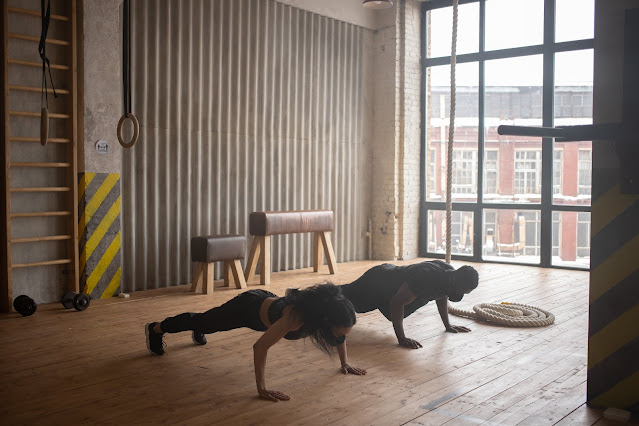Exercise Workouts At Home l Daily Health Idea
 |
| Exercise Workouts At Home |
Home Workouts: Your Ultimate Guide to Fitness Within Your Four Walls
Outline
I. Introduction
- A.
Rise of Home Workouts
- B.
Benefits of Exercising at Home
II. Types of Home Workouts
- A.
Bodyweight Exercises
- B.
Cardiovascular Workouts
- C.
Yoga and Pilates
III. Setting Up a Home Workout Space
- A.
Utilizing Limited Space
- B.
Essential Equipment for Home Workouts
IV. Bodyweight Exercises for Home Workouts
- A.
Push-Ups and Variations
- B.
Squats and Lunges
- C.
Plank Variations
- D.
Burpees
V. Cardiovascular Workouts at Home
- A.
Jump Rope Exercises
- B.
High-Intensity Interval Training (HIIT)
- C.
Dance Workouts
VI. Incorporating Yoga and Pilates
- A.
Flexibility and Strength Building
- B.
Mind-Body Connection
VII. Creating a Home Workout Routine
- A.
Designing a Balanced Schedule
- B.
Setting Realistic Goals
- C. Consistency
and Progress Tracking
VIII. Overcoming Challenges of Home Workouts
- A.
Staying Motivated
- B.
Dealing with Distractions
- C.
Finding Accountability Partners
IX. Benefits of Home Workouts
- A.
Convenience and Time Efficiency
- B.
Cost-Effective
- C.
Privacy and Comfort
X. Safety Tips for Home Workouts
- A.
Warm-Up and Cool Down
- B.
Proper Form and Technique
- C.
Listening to Your Body
XI. Frequently Asked Questions (FAQs)
- A.
Can I build muscle with home workouts?
- B.
How long should a home workout session be?
- C. Is
it necessary to have a dedicated workout space at home?
- D.
Are home workouts suitable for beginners?
- E.
Can home workouts replace gym workouts?
XII. Conclusion
- A.
Recap of Home Workout Benefits
- B.
Encouragement for Embracing Home Fitness
XIII. Unique FAQs
- A.
How can I stay motivated for home workouts in the long term?
- B.
Are there specific home workouts for stress relief?
- C.
Can I do home workouts if I have limited mobility?
- D.
What's the role of nutrition in supporting home workout results?
- E.
How can parents incorporate home workouts into their busy schedules?
I. Introduction
A. Rise of Home Workouts
In recent years, the trend of exercising at home has gained immense popularity, driven by convenience and accessibility.
B. Benefits of Exercising at Home
Home workouts offer flexibility, time efficiency, and the
comfort of your own space. Let's explore the diverse range of exercises you can
do within the confines of your home.
II. Types of Home Workouts
A. Bodyweight Exercises
No fancy equipment needed—bodyweight exercises are effective for strength training and can be adapted to all fitness levels.
B. Cardiovascular Workouts
Elevate your heart rate with cardio exercises that require minimal space, such as jumping jacks, high knees, and mountain climbers.
C. Yoga and Pilates
Improve flexibility, balance, and core strength through the
practice of yoga and Pilates, fostering a mind-body connection.
III. Setting Up a Home Workout Space
A. Utilizing Limited Space
You don't need a dedicated room; a corner or even your
living room can serve as a functional workout space.
B. Essential Equipment for Home Workouts
While many exercises require no equipment, investing in basics like resistance bands and dumbbells can add variety to your routine.
IV. Bodyweight Exercises for Home Workouts
A. Push-Ups and Variations
B. Squats and Lunges
Target your lower body with squats and lunges, building
strength in your quads, hamstrings, and glutes.
C. Plank Variations
Planks engage your core muscles; experiment with side planks
and plank rotations for added challenge.
D. Bur pees
A full-body exercise that combines strength and cardio,
bur pees are excellent for calorie burning and overall conditioning.
V. Cardiovascular Workouts at Home
A. Jump Rope Exercises
A simple yet effective cardio tool, jumping rope elevates
your heart rate and improves coordination.
B. High-Intensity Interval Training (HIIT)
HIIT involves short bursts of intense exercise followed by
rest periods, making it a time-efficient way to burn calories.
C. Dance Workouts
Turn on your favorite music and dance—it's a fun way to stay
active while improving cardiovascular health.
VI. Incorporating Yoga and Pilates
A. Flexibility and Strength Building
Yoga and Pilates enhance flexibility, promote relaxation,
and contribute to overall strength.
B. Mind-Body Connection
These practices focus on mindfulness, helping reduce stress
and improve mental well-being.
VII. Creating a Home Workout Routine
A. Designing a Balanced Schedule
Include a mix of strength training, cardio, and flexibility
exercises in your weekly routine.
B. Setting Realistic Goals
Establish achievable fitness goals to stay motivated and
track your progress over time.
C. Consistency and Progress Tracking
Consistency is key; monitor your achievements to stay
motivated on your fitness journey.
VIII. Overcoming Challenges of Home Workouts
A. Staying Motivated
Keep things interesting by trying new exercises, and
consider incorporating virtual classes or workout apps for variety.
B. Dealing with Distractions
Create a dedicated workout time, minimize distractions, and
focus on the benefits of staying active.
C. Finding Accountability Partners
Join online fitness communities or enlist a workout buddy to
keep each other motivated and accountable.
IX. Benefits of Home Workouts
A. Convenience and Time Efficiency
Eliminate commute time and fit workouts into your schedule
with ease.
B. Cost-Effective
Save on gym memberships and commute costs by investing in
minimal equipment for home workouts.
C. Privacy and Comfort
Enjoy the privacy of your home environment, allowing you to
focus on your fitness goals without external distractions.
X. Safety Tips for Home Workouts
A. Warm-Up and Cool Down
Prioritize warm-up exercises to prepare your muscles and
include a cool-down to aid in recovery.
B. Proper Form and Technique
Maintain proper form to prevent injuries; if unsure, seek
guidance from online tutorials or fitness professionals.
C. Listening to Your Body
Pay attention to your body's signals and adjust the
intensity of your workouts accordingly.
XI. Frequently Asked Questions (FAQs)
A. Can I build muscle with home workouts?
Yes, bodyweight exercises








Post a Comment